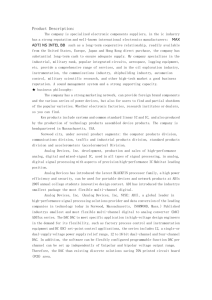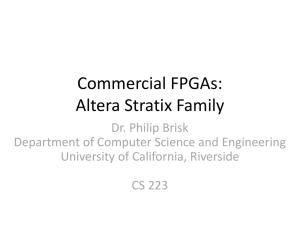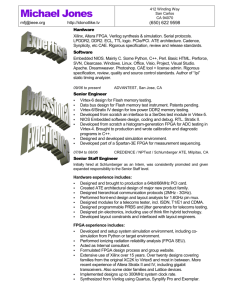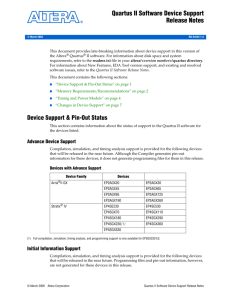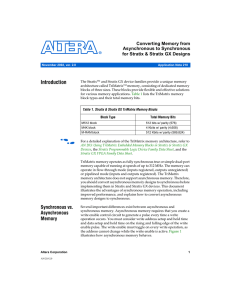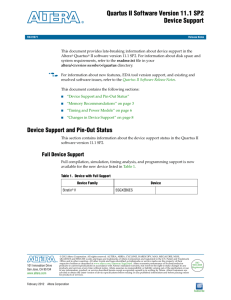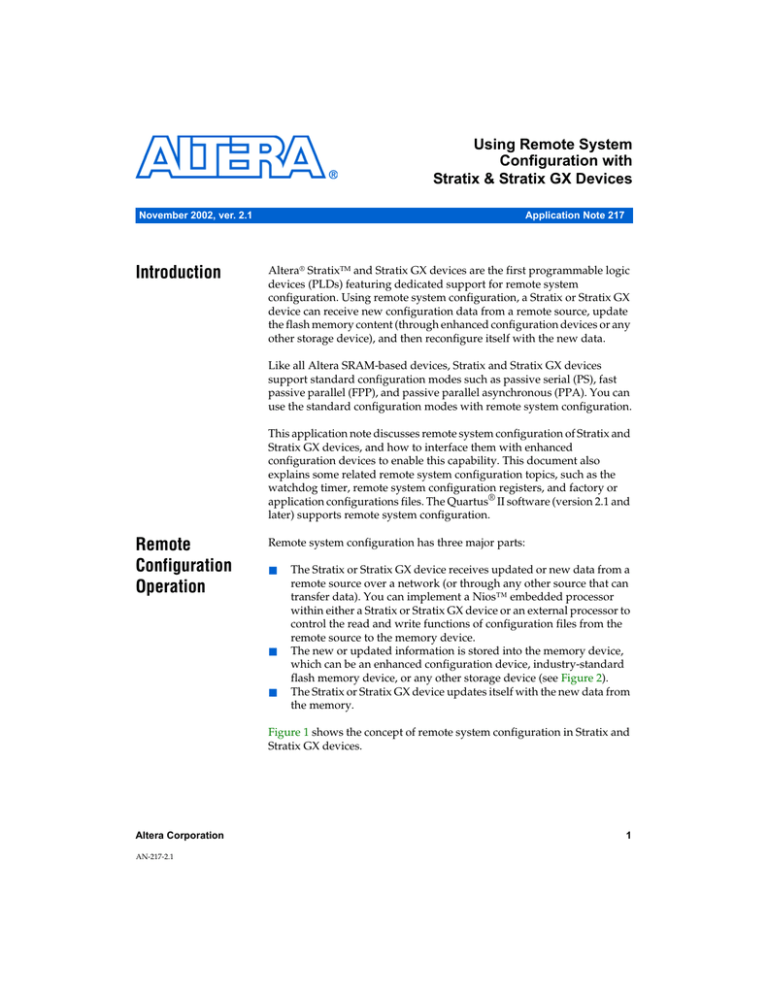
Using Remote System
Configuration with
Stratix & Stratix GX Devices
November 2002, ver. 2.1
Introduction
Application Note 217
Altera® StratixTM and Stratix GX devices are the first programmable logic
devices (PLDs) featuring dedicated support for remote system
configuration. Using remote system configuration, a Stratix or Stratix GX
device can receive new configuration data from a remote source, update
the flash memory content (through enhanced configuration devices or any
other storage device), and then reconfigure itself with the new data.
Like all Altera SRAM-based devices, Stratix and Stratix GX devices
support standard configuration modes such as passive serial (PS), fast
passive parallel (FPP), and passive parallel asynchronous (PPA). You can
use the standard configuration modes with remote system configuration.
This application note discusses remote system configuration of Stratix and
Stratix GX devices, and how to interface them with enhanced
configuration devices to enable this capability. This document also
explains some related remote system configuration topics, such as the
watchdog timer, remote system configuration registers, and factory or
application configurations files. The Quartus® II software (version 2.1 and
later) supports remote system configuration.
Remote
Configuration
Operation
Remote system configuration has three major parts:
■
■
■
The Stratix or Stratix GX device receives updated or new data from a
remote source over a network (or through any other source that can
transfer data). You can implement a Nios™ embedded processor
within either a Stratix or Stratix GX device or an external processor to
control the read and write functions of configuration files from the
remote source to the memory device.
The new or updated information is stored into the memory device,
which can be an enhanced configuration device, industry-standard
flash memory device, or any other storage device (see Figure 2).
The Stratix or Stratix GX device updates itself with the new data from
the memory.
Figure 1 shows the concept of remote system configuration in Stratix and
Stratix GX devices.
Altera Corporation
AN-217-2.1
1
Using Remote System Configuration with Stratix & Stratix GX Devices
Figure 1. Remote System Configuration with Stratix & Stratix GX Devices
Network
Data
Development
Location
Data
Data
Stratix or
Stratix GX
Device
Control Module
Memory
Stratix Device Configuration
Figure 2. Different Options for Remote System Configuration
External
Processor
Enhanced
Configuration
Device
MAX Device &
Flash Memory
Stratix or
Stratix GX
Device
Stratix or
Stratix GX
Device
Nios
Processor
Stratix or
Stratix GX
Device
Nios
Processor
Processor
MAX
Device
Enhanced
Configuration
Device
Flash
Memory
Flash
Remote System Configuration Modes
Stratix and Stratix GX device remote system configuration has two modes:
remote configuration mode and local configuration mode. Table 1 shows
the pin selection settings for each configuration mode.
2
Altera Corporation
Using Remote System Configuration with Stratix & Stratix GX Devices
Table 1. Standard, Remote & Local Configuration Options
Note (1)
RUnLU (2)
MSEL[2] (3)
–
–
–
0
MSEL[1..0] System Configuration Mode
00
Standard
Configuration Mode
FPP
0
01
Standard
PPA
0
10
Standard
PS
1
1
00
Remote
FPP
1
1
01
Remote
PPA
1
1
10
Remote
PS
0
1
00
Local
FPP
0
1
01
Local
PPA
0
1
10
Local
PS
Notes to Table 1:
(1)
(2)
(3)
For detailed information on standard PS, FPP, and PPA models, refer to AN 208: Configuring Stratix & Stratix GX
Devices.
In Stratix and Stratix GX devices, the RUnLU (remote update/local update) pin, selects between local or remote
configuration mode.
The MSEL[2] select mode selects between standard or remote system configuration mode.
Remote Configuration Mode
Using remote configuration mode, you can manage up to seven different
application configurations for Stratix and Stratix GX devices. The sevenconfiguration-file limit is due to the number of pages that the PGM[] pins
in the Stratix or Stratix GX device and enhanced configuration devices can
select.
1
If more than seven files are sent to a system using remote
configuration mode, previous files will be overwritten.
Stratix and Stratix GX devices support remote configuration mode for PS,
FPP, and PPA modes. Specify remote configuration mode by setting the
MSEL2 and RUnLU pins to high. (See Table 1).
On power-up in remote configuration mode, the Stratix or Stratix GX
device loads the user-specified factory configuration file, located in the
default page address 000 in the enhanced configuration device. After the
device configures, the remote configuration control register points to the
page address of the application configuration that should be loaded into
the Stratix or Stratix GX device. If an error occurs during user mode of an
application configuration, the device reloads the default factory
configuration page. Figure 3 shows a diagram of remote configuration
mode.
Altera Corporation
3
Using Remote System Configuration with Stratix & Stratix GX Devices
Figure 3. Remote Configuration Mode
Power Up
Reconfigure
Configuration
Error
Factory
Configuration
Page (000)
Errors
Application 1
Configuration
PGM [001]
Reconfigure
Errors
Application 7
Configuration
PGM [111]
Local Configuration Mode
Local configuration mode—a simplified version of remote configuration
mode—is suitable for systems that load an application immediately upon
power-up. In this mode you can only use one application configuration,
which you can update either remotely or locally.
In local configuration mode, upon power-up, or when nCONFIG is
asserted, the Stratix or Stratix GX device loads the application
configuration immediately. Factory configuration loads only if an error
occurs during the application configuration’s user mode. If you use an
enhanced configuration device, page address 001 is the location for the
application configuration data, and page address 000 is the location for
the factory configuration data.
If the configuration data at page address 001 does not load correctly due
to cyclic redundancy code (CRC) failure, or it times-out of the enhanced
configuration device, or the external processor times-out, then the factory
configuration located at the default page (page address 000) loads into
the Stratix or Stratix GX device.
In local configuration mode (shown in Figure 4), the user watchdog timer
is disabled. For more information on the watchdog timer, see “Watchdog
Timer” on page 7.
4
Altera Corporation
Using Remote System Configuration with Stratix & Stratix GX Devices
Figure 4. Local Configuration Mode
Power Up or
nCONFIG Assertion
Configuration Error
nCONFIG
Factory
Configuration
PGM[000]
Application
Configuration
PGM[001]
nCONFIG
Configuration
Error
In local configuration mode, one application configuration is available to
the device. For remote or local configuration mode selection, refer to
Table 1.
Remote System Configuration Components
The following components are used in Stratix and Stratix GX devices to
support remote and local configuration modes. A description of each
component follows.
■
■
■
■
■
■
Page mode feature
Factory configuration
Application configuration
Watchdog timer
Remote update sub-block
Remote configuration registers
Page Mode Feature
The page mode feature enables Stratix and Stratix GX devices to select a
location to read back data for configuration. The enhanced configuration
device can receive and store up to eight different configuration files (one
factory and seven application files). Selection of pages to read from is
performed through the PGM[2..0] pins on the Stratix or Stratix GX
device and enhanced configuration devices. These pins in the Stratix or
Stratix GX device can be designated user I/O pins during standard
configuration mode, but in remote system configuration mode, they are
dedicated output pins. Figure 5 shows the page mode feature in Stratix or
Stratix GX devices and enhanced configuration devices.
Altera Corporation
5
Using Remote System Configuration with Stratix & Stratix GX Devices
Figure 5. Page Mode Feature in Stratix or Stratix GX Devices & Enhanced
Configuration Devices
Enhanced Configuration
Device
POF 8
tix7
Stratix or
Stratix GX
Device
POF 1
Stratix 1
Page0
Page Select
Upon power-up in remote configuration mode, the factory configuration
(see description below) selects the user-specified page address through
the Stratix or Stratix GX PGM[2..0] output pins. These pins drive the
PGM[2..0] input pins of the enhanced configuration device and select
the requested page in the memory.
If an intelligent host is used instead of an enhanced configuration device,
you should create logic in the intelligent host to support page mode
settings similar to that in enhanced configuration devices.
Factory Configuration
Factory configuration is the default configuration data setup. In enhanced
configuration devices, this default page address is 000. Factory
configuration data is written into the memory device only once by the
system manufacturer and should not be remotely updated or altered. In
remote configuration mode, the factory configuration loads into the
Stratix or Stratix GX device upon power-up.
The factory configuration specifications are as follows:
■
■
■
■
6
Receives new configuration data and writes it to the enhanced
configuration or other memory devices
Determines the page address for the next application configuration
that should be loaded to the Stratix or Stratix GX device
Upon an error in the application configuration, the system reverts to
the factory configuration
Determines the reason for any application configuration error
Altera Corporation
Using Remote System Configuration with Stratix & Stratix GX Devices
■
■
■
Determines whether to enable or disable the user watchdog timer for
application configurations
Determines the user watchdog timer’s settings if the timer is enabled
(remote configuration mode)
If the user watchdog timer is not reset after a predetermined amount
of time, it times-out and the system loads the factory configuration
data back to the Stratix or Stratix GX device
If a system encounters an error while loading application configuration
data, or if the device re-configures due to nCONFIG assertion, the Stratix
or Stratix GX device loads the factory configuration. The remote system
configuration register determines the reason for factory re-configuration.
Based on this information, the factory configuration determines which
application configuration needs to be loaded.
Application Configuration
The application configuration is the configuration data received from the
remote source and updated into different locations or pages of the
memory storage device (excluding the factory default page).
Watchdog Timer
A watchdog timer is a circuit that determines whether another mechanism
functions properly. The watchdog timer functions like a time-delay relay
that remains in the reset state while an application runs properly. This
action periodically sends a reset command from the working application
to the watchdog timer. Stratix and Stratix GX devices are equipped with a
built-in watchdog timer for remote system configuration.
A user watchdog timer prevents a faulty application configuration from
indefinitely stalling the Stratix or Stratix GX device. The timer functions as
a counter that counts down from an initial value, which is loaded into the
device from the factory configuration. This is a 29-bit counter, but you will
use only the upper 12 bits to set the value for the watchdog timer. You
specify the counter value according to your design needs.
The timer begins counting once the Stratix or Stratix GX device goes into
user mode. If the application configuration does not reset the user
watchdog timer after the specified time, then the timer times-out. At this
point, the Stratix or Stratix GX device will be re-configured by loading the
factory configuration and resetting the user watchdog timer.
1
Altera Corporation
The watchdog timer is disabled in local configuration mode.
7
Using Remote System Configuration with Stratix & Stratix GX Devices
Remote Update Sub-Block
The remote update sub-block is responsible for administrating the remote
configuration feature. This sub-block, which is controlled by a remote
configuration state machine, generates the control signals required to
control different remote configuration registers.
Remote Configuration Registers
Remote configuration registers are a series of registers required to keep
track of page addresses and the cause of configuration errors. Table 2
gives descriptions of the registers’ functions. You can control both the
update and shift registers; the status and control registers are controlled
by internal logic, but can be read via the shift register.
Table 2. Remote Configuration Registers
Register
Description
Control register
This register contains the current page address, the watchdog timer setting, and one
bit specifying if the current configuration is a factory or application configuration.
During a capture in an application configuration, this register is read into the shift
register.
Update register
This register contains the same data as the control register, except that it is updated
by the factory configuration. The factory configuration updates the register with the
values to be used in the control register on the next re-configuration. During
capture in a factory configuration, this register is read into the shift register.
Shift register
This register is accessible by the core logic and allows the update, status, and
control registers to be written and sampled by the user logic. The update register can
only be updated in factory application or remote configuration.
Status register
This register is written into by the remote configuration block on every reconfiguration to record the cause of the re-configuration. This information will be
used by factory configuration to determine the appropriate action following a reconfiguration.
Figure 6 shows the control, update, shift, and status registers and the data
path used to control remote system configuration.
8
Altera Corporation
Using Remote System Configuration with Stratix & Stratix GX Devices
Figure 6. Remote Configuration Registers & Related Data Path
Status Register
Control Register
Bit4...Bit10
Bit16...Bit0
Logic
to Reconfig Logic
Update Register
Bit0...Bit16
User
Watchdog
Timer
Shift Register
Control Logic
RU_Dout
RU_shftnhld
RU_captnupdt
RU_Din
RU_clk
RU_Timer
RU_nCONFIG
Device Core
Table 3 describes the user configuration signals that are driven to/from
the device core. The remote configuration logic has one input signal to the
device core and six output signals from the device core.
Table 3. User Configuration Signals To/From Device Core (Part 1 of 2)
Signal Name
To/From Device Core
Description
RU_Timer
Output from the core to the remote
update block
Request from the application to reset the user
watchdog timer with its initial count. A falling edge of
this signal triggers a reset of the user watchdog
timer.
RU_nCONFIG
Output from the core to the remote
update block
When driven low, this signal triggers the device to
reconfigure. If requested by the factory configuration,
the application configuration specified in the remote
update control register is loaded. If requested by the
application configuration, the factory configuration is
loaded.
RU_Clk
Output from the core to the remote
update block
Clocks the remote configuration shift register so that
the contents of the status and control registers can
be read out, and the contents of update register can
be loaded. The shift register latches data on the
rising edge of the RU_Clk.
Altera Corporation
9
Using Remote System Configuration with Stratix & Stratix GX Devices
Table 3. User Configuration Signals To/From Device Core (Part 2 of 2)
RU_shftnhld
Output from the core to the remote
update block
If its value is “1”, the remote configuration shift
register shifts data on the rising edge of RU_Clk. It
its value is “0” and RU_captnupdt is “0”, the shift
register will update the update register. If its value is
“0”, and RU_captnupdt is “1”, the shift register will
capture the status register and either the control or
update register (depending on whether the
configuration is factory or application).
RU_captnupdt
Output from the core to the remote
update block
When RU_captnupdt is at value “1” and
RU_shftnhld is at value”0”, the system specifies
that the remote configuration shift register should be
written with the content of the status register and
either the update register (in a factory configuration)
or the control register (in an application
configuration). This shift register is loaded on the
rising edge of RU_Clk. When RU_captnupdt is at
value “0” and RU_shftnhld is at value”0”, the
system specifies that the remote configuration
update register should be written with the content of
the shift register in a factory configuration. The
update register is loaded on the rising edge of
RU_Clk. This pin is enabled only for factory
configuration in remote configuration mode (it is
disabled for the application configuration in remote
configuration or for local configuration modes). If
RU_shftnhld is at value “1”, RU_captnupdt has
no function.
RU_Din
Output from the core to the remote
update block
Data to be written into the remote configuration shift
register on the rising edge of RU_Clk. To load into
the shift register, RU_shftnhld must be asserted.
RU_Dout
Input to the core from the remote
update block
Output of the remote configuration shift register to be
read by core logic. New data arrives on each rising
edge of RU_Clk.
All of the seven device core signals (see Figure 6), are enabled for both
remote and local configuration for both factory and application
configuration, except RU_Timer and RU_captnupdt. Figure 7 and
Table 4 specify the content of control register upon power-on reset (POR).
The difference between local configuration and remote configuration is
how the control register is updated during a re-configuration and which
core signals are enabled.
10
Altera Corporation
Using Remote System Configuration with Stratix & Stratix GX Devices
Figure 7. Remote System Configuration Control Register
Table 4 shows the content of the control register upon POR.
Table 4. Control Register Contents
Parameter
Definition
POR Reset Value
Comment
Current configuration is factory or
applications
1 bit ‘1’
Applications
1 bit ‘0’
Factory
PGM[2..0]
Page mode selection
3 bits ‘001’
Local configuration
3 bits ‘000’
Remote configuration
Wd_en
User watchdog timer enable
1 bit ‘0’
Wd_timer
[11..0]
User watchdog timer time-out value 12 bits ‘0’
AnF
–
High order bits of 29 bit counter
The status register specifies the reason why re-configuration has occurred
and determines if the re-configuration was due to a CRC error, nSTATUS
pulled low due to an error, the device core caused an error, nCONFIG was
reset, or the watchdog timer timed-out. Figure 8 and Table 5 specify the
content of the status register.
Figure 8. Remote System Configuration Status Register
Altera Corporation
4
3
2
1
0
Wd
nCONFIG
CORE
nSTATUS
CRC
11
Using Remote System Configuration with Stratix & Stratix GX Devices
Table 5 shows the content of the status register upon POR.
Table 5. Status Register Contents
Parameter
Definition
POR Reset Value
CRC (from
configuration)
CRC caused re-configuration
1 bit ‘0’
nSTATUS
nSTATUS caused re-configuration
1 bit ‘0’
CORE (1)
Device core caused re-configuration
1 bit ‘0’
nCONFIG
NCONFIG caused re-configuration
1 bit ‘0’
Wd
Watchdog Timer caused re-configuration 1 bit ‘0’
Note to Table 5:
(1)
Quartus II
Software
Support
Core re-configuration enforces the system to load the application configuration
data into the Stratix or Stratix GX device. This occurs after factory configuration
specifies the appropriate application configuration data.
The Quartus II software version 2.1 supports remote and local
configuration modes. To access Stratix and Stratix GX devices for remote
configuration with the Quartus II software version 2.1, insert a what-yousee-is-what-you-get (WYSIWYG) atom into the design. Without this
ATOM, you will not be able to access the Stratix or Stratix GX device core
and perform remote configuration with the Quartus II software.
To specify in the software that a remote or local configuration is planned,
select the remote or local update mode under Compiler Settings, prior to
the compilation. This selection will reserve the RUnLU and PGM pins for
remote/local configuration.
Quartus II Support for Local Configuration Scheme
To set the local configuration scheme, follow these steps:
12
1.
Click the Chips & Devices tab in the Compiler Settings dialog box
(Processing menu). The Compiler Settings dialog box is displayed.
2.
Click the Device & Pin Options button. The Device & Pin Options
dialog box is displayed.
3.
Click the Configuration tab.
4.
In the Configuration mode list, select Local.
Altera Corporation
Using Remote System Configuration with Stratix & Stratix GX Devices
Figure 9 shows the Device & Pin Options dialog box. After compilation,
the Quartus II software will reserve RUnLU, along with other
configuration pins. For local configuration, the MSEL[2] pin should be
connected to VCC, and the RUnLU pin should be connected to GND (see
Table 1).
Figure 9. Compiler Setting for Local Configuration Scheme
Local Configuration Set-Up
To target an enhanced configuration device for remote and local
configuration, the SRAM Object File (.sof) should convert to a
Programming Object File (.pof) or Hexadecimal File (.hex) format, by
following these steps:
Altera Corporation
1.
Go to Convert Programming File (Tools menu).
2.
Select “Programming Object File (.pof)” from the drop-down list
under Programming file type.
3.
Select “EPC16 (or EPC8)” from the drop-down list under
Configuration device.
4.
Select the required configuration mode (“1-bit Passive Serial” or
“Fast Passive Parallel”) from the drop-down menu under Mode.
13
Using Remote System Configuration with Stratix & Stratix GX Devices
5.
In the File name box, type the POF file name for the factory page.
(The first conversion is for the factory configuration file, which
resides at page0 of the enhanced configuration device.)
6.
Click Options and select any required settings (such as compression
mode, clock setting, and so on). Only during the factory
configuration file conversion can you specify the Options,
Configuration device, or Mode settings. While generating the
application configuration file, all of these settings are grayed out and
inaccessible.
7.
In the Input files to convert box, highlight “SOF Data” at “Page0”
and click Add File.
8.
Click OK. This will generate the POF for the factory image at
“Page 0”.
Figure 10 shows the options in the Convert Programming Files dialog
box for the factory configuration file in local configuration scheme.
14
Altera Corporation
Using Remote System Configuration with Stratix & Stratix GX Devices
Figure 10. Factory Configuration Set-Up in Local Configuration Scheme
Altera Corporation
15
Using Remote System Configuration with Stratix & Stratix GX Devices
To add the application configuration file to the next page in the enhanced
configuration device, perform the following steps:
1.
Open the Convert Programming Files dialog box (Tools menu).
2.
Under Programming file type select “Programmer Object File for
Local Update (.pof)”. The Options, Configuration device, and
Mode settings are grayed out and inaccessible for application
configuration because these settings are for the factory configuration
file.
3.
There is an optional selection called Remote/Local update
Difference file. This box will be available only when “Programmer
Object File for Local Update (.pof)” or “Programmer Object File for
Remote Update (.pof)” is selected. For local update, the difference
file contains the data added to page 1 of a POF. The output difference
file can be in .hexout, .jbc or .jam file format.
4.
Go to Input files to convert and highlight the “SOF Data” at
“Page 1” and click Add File. This will load the application
configuration data at page 1.
5.
Highlight “POF Data” at “Page 0” and click Add File. Select the POF
file generated for the factory configuration at “Page 0”.
6.
After uploading both programming files, specify a name for this new
POF file in the File Name box.
7.
Click OK to generate the POF file.
Figure 11 shows the Convert Programming File dialog box and its
various selections for the application configuration file in local update.
16
Altera Corporation
Using Remote System Configuration with Stratix & Stratix GX Devices
Figure 11. Application Configuration Set-Up in Local Configuration Scheme
Quartus II Support for Remote Configuration Scheme
When using the remote configuration scheme in the Quartus II software
version 2.1, add the remote update WYSIWYG atom to your design in
order to access the core of the Stratix or Stratix GX device. This atom
should be included in the factory configuration design or any other
application configuration designs that need to enable this scheme.
Without this atom, you will not be able to use this scheme.
Remote Update WYSIWYG Atom
This section describes the remote update WYSIWYG atom in detail. The
following items should be considered when implementing the atom:
Altera Corporation
1.
Only one atom can be used in the circuit; more than one will give a
no-fit.
2.
All signals for the cell must be connected. The clock port (CLK) must
be connected to a live cell. The others can be constant VCC or GND.
17
Using Remote System Configuration with Stratix & Stratix GX Devices
3.
The pgmout port must be connected and must feed PGM[2.0]
output pins (it cannot be connected to anything else but output
pins).
4.
The Quartus II software will reserve RUnLU as an input pin, and you
must connect it to VCC.
Remote Update Primitives
Figure 12 shows the remote update primitives.
Figure 12. Remote Update Primitive
Stratix_rublock <rublock_name>
(
.clk(<clock source>),
.shiftnld(<shiftnld source>),
.captnupdt(<shiftnld source>),
.regin(<regin input source from the core>),
.rsttimer(<input signal to reset the watchdog timer>),
.config(<input signal to initiate configuration>),
.regout(<data output destination to core>),
.pgmout(<program output destinations to pins>),
);
Table 6 shows the remote update block input and output port names and
descriptions of each.
Table 6. Remote Update Block Input & Output Ports (Part 1 of 2)
Ports
Definition
<rublock_name>
The unique identifier for the instance. This identifier name can be
anything as long as it is legal for the given description language (i.e.,
Verilog, VHDL, AHDL, etc.). This field is required.
.clk(<clock source>)
Designates the clock input of this cell. All operation is with respect to the
rising edge of this clock. This field is required.
.shiftnld(<shiftnld source>)
An input into the remote configuration block. When .shiftnld = 1, the
data shifts from the internal shift registers to the regout port at each
rising edge of clk, and the data also shifts into the internal shift registers
from regin port. This field is required.
18
Altera Corporation
Using Remote System Configuration with Stratix & Stratix GX Devices
Table 6. Remote Update Block Input & Output Ports (Part 2 of 2)
Ports
Definition
.captnupdt(<shiftnld source>)
An input into the remote configuration block. This controls the protocol of
when to read the configuration mode or when to write into the registers
that control the configuration. This field is required.
.regin(<regin input source from the
core>)
An input into the configuration block for all data loading into the core. The
data shifts into the internal registers at the rising edge of clk. This field
is required.
.rsttimer(<input signal to reset the
watchdog timer>)
An input into the watchdog timer of the remote update block. When this
is high, it resets the watchdog timer. This field is required.
.config(<input signal to initiate
configuration>)
An input into the configuration section of the remote update block. When
this signal goes high, the part initiates a re-configuration. This field is
required.
.regout(<data output destination to
core>)
A 1-bit output, which is the output of the internal shift register, and
updated every rising edge of clk. The data coming out depends on the
control signals. This field is required.
.pgmout(<program output
destinations to pins>)
A 3-bit bus. It should always be connected only to output pins (not bidir
pins). This bus gives the page address (000 to 111) of the configuration
data to be loaded when the device is getting configured. This field is
required.
f
For more information on the control signals for the remote update block
see Table 3 on page 9.
Remote Configuration Set Up
For remote configuration, select Remote under Configuration mode in
the Configuration tab located in the Device & Pin Options dialog box
(Processing menu). Figure 13 shows the Device & Pin Options dialog
box. After compilation, the Quartus II software will reserve RUnLU, along
with other configuration pins. For remote configuration scheme, both
MSEL[2] and the RUnLU pins should be connected to VCC (see Table 1).
Altera Corporation
19
Using Remote System Configuration with Stratix & Stratix GX Devices
Figure 13. Compiler Setting for Remote Configuration Scheme
1
To target an enhanced configuration device for remote and local
configuration, follow the steps found under the section, “Local
Configuration Set-Up” on page 13.
Figure 14 shows the options in the Convert Programming Files dialog
box for the factory configuration file in remote configuration scheme.
20
Altera Corporation
Using Remote System Configuration with Stratix & Stratix GX Devices
Figure 14. Factory Configuration Set-Up in Remote Configuration Scheme
To add the application configuration file (or files) to the next page in the
enhanced configuration device, perform the following steps:
Altera Corporation
1.
Open the Convert Programming Files dialog box (Tools menu).
2.
Under Programming file type select “Programmer Object File for
Local Update (.pof)”. The Options, Configuration device, and
Mode settings are grayed out and inaccessible for application
configuration because these settings are for the factory configuration
file.
3.
There is an optional selection called Remote/Local update
Difference file. This box will be available only when “Programmer
Object File for Local Update (.pof)” or “Programmer Object File for
Remote Update (.pof)” is selected. For remote update, the difference
file contains the data for new pages added to a POF. The output
difference file can be in .hexout, .jbc or .jam file format.
21
Using Remote System Configuration with Stratix & Stratix GX Devices
4.
Go to Input files to convert and highlight the “SOF Data” at “Page
1” and click Add File. This will load the application configuration
data at page 1.
5.
If there is more than one applications configuration file, repeat step 4
for all the existing files. When adding a new SOF, click Properties in
the Convert Programming Files dialog box and specify the page that
the file should load to.
1
Keep in mind the density of the targeted enhanced configuration
devices and the number of programming files allowed for that
density. If you exceed the device’s capacity, an error message
will appear: “Size of file/s in main block exceed memory
capacity”.
6.
Highlight “POF Data” at “Page 0” and click Add File. Select the POF
file generated for the factory configuration at “Page 0”.
7.
After uploading both programming files, specify a name for this new
POF file in the File Name box.
8.
Click OK to generate the POF file.
If the Compression option is not selected while generating factory POF
file, you may not be able to fit more than one or two programming files in
the enhanced configuration device.
Figure 15 shows the Convert Programming Files dialog box for three
configuration files in remote configuration scheme. For this setup, the
Compression option is selected during factory configuration POF
generation.
22
Altera Corporation
Using Remote System Configuration with Stratix & Stratix GX Devices
Figure 15. Application Configuration Set-Up in Remote Configuration Mode
Using
Enhanced
Configuration
Devices
This section describes remote system configuration of Stratix and
Stratix GX devices with the Nios embedded processor using enhanced
configuration devices. Enhanced configuration devices are composed of a
standard flash memory and a controller. The flash memory stores
configuration data, and the controller reads and writes to the flash
memory.
In remote system configuration, only PS and FPP modes are supported
using an enhanced configuration device. A Stratix or Stratix GX device
running a Nios embedded processor can receive data from a remote
source through a network or any other appropriate media. A specific page
of the enhanced configuration device stores the received data.
This scheme uses the page mode option in Stratix and Stratix GX devices.
Up to eight pages can be stored in each enhanced configuration device,
each of which can store a configuration file.
Altera Corporation
23
Using Remote System Configuration with Stratix & Stratix GX Devices
In enhanced configuration devices, a page is a section of the flash memory
space. Its boundary is determined by the Quartus II software (the page
size is programmable). In the software, you can specify which
configuration file should be stored in which page within the flash
memory. To access the configuration file on each page, set the three input
pins (PGM[2..0]), which provide access to all eight pages. Because the
PGM[2..0] pins of an enhanced configuration device connect to the same
pins of the Stratix or Stratix GX device, the Stratix or Stratix GX device
selects one of the eight memory pages as a target location to read from.
Figure 16 shows the allocation of different pages in the enhanced
configuration device.
f
For more information on enhanced configuration devices, refer to the
Enhanced Configuration Devices (EPC4, EPC8 & EPC16) Data Sheet and
AN 218: Using Altera’s Enhanced Configuration Devices.
Figure 16. Memory Map in Enhanced Configuration Device
Enhanced Configuration Devices
Processor
Space
Unused Memory
Page7
Configuration
Space
Page1
Page0
Option Bits
Boot & Parameter Block
When the Stratix or Stratix GX device powers-up in remote configuration
mode, the devices loads configuration data located at page address 000.
You should always load the factory default configuration data at this
location and make sure this information is not altered.
24
Altera Corporation
Using Remote System Configuration with Stratix & Stratix GX Devices
The factory configuration contains information to determine the next
application configuration to load into the Stratix or Stratix GX device.
When the Stratix or Stratix GX device successfully loads the application
configuration from the page selected by the PGM[2..0] pins, it enters
user mode.
In user mode, the Nios embedded processor (or any other logic) assists the
Stratix or Stratix GX device in detecting remote system configuration
information. In remote system configuration, the Nios embedded
processor receives the incoming data from the remote source via the
network, writes it to the ECP16 enhanced configuration device, and then
initiates loading of the factory configuration into the Stratix or Stratix GX
device. Factory configuration reads the remote configuration status
register and determines the appropriate application configuration to load
into the Stratix or Stratix GX device. Figure 17 shows the remote system
configuration.
Figure 17. Remote System Configuration Using Enhanced Configuration Devices
Stratix or
Stratix GX Device
Application
Configuration Data
Remote Source
Application
Configuration Data
Enhanced
Configuration Device
Application Data 1
Nios
Processor
PGM[2..0]
Application/Factory
Configuration Data
(Network)
Watchdog
Circuitry
Application Data 7
Configuration
Control Signals
Factory Data
Selecting Next
Application from
Factory Data
The user watchdog timer in Stratix and Stratix GX devices ensures that an
application configuration has loaded successfully and checks if the
application configuration is operating correctly in user mode. The
watchdog timer must be continually reset by the user logic. If an error
occurs while the application configuration loads, or if the watchdog timer
times-out during user mode, the factory configuration is reloaded to
prevent the system from halting in an erroneous state. Figure 3 on page 4
illustrates the remote configuration mode.
Upon power-up in local configuration scheme, the application
configuration at page 001 (PGM[001] of the enhanced configuration
device) loads into the Stratix or Stratix GX device. This application can be
remotely or locally updated. If an error occurs during loading of the
configuration data, the factory configuration loads automatically (see
Figure 4 on page 5). The rest is identical to remote configuration mode.
Altera Corporation
25
Using Remote System Configuration with Stratix & Stratix GX Devices
Combining
MAX Devices &
Flash Memory
This section describes remote system configuration with the Stratix or
Stratix GX device and the Nios embedded processor, using a combination
of MAX® devices and flash memory.
You can use MAX 3000 or MAX 7000 devices and an industry-standard
flash memory device instead of enhanced configuration devices. In this
scheme, flash memory stores configuration data, and the MAX device
controls reading and writing to the flash memory, keeping track of
address locations.
The MAX device determines which address location and at what length to
store configuration data in flash memory. The Nios embedded processor,
running in the Stratix or Stratix GX device, receives the incoming data
from the remote source and writes it to the address location in flash
memory. The Nios embedded processor initiates loading of factory
configuration into the Stratix or Stratix GX device. Figure 18 shows
remote system configuration using a MAX device and flash memory
combination.
Figure 18. Remote System Configuration Using a MAX Device & Flash Memory
Stratix or
Stratix GX Device
Application
Configuration Data
Remote Source
Nios
Processor
MAX & Flash Memory
Application/Factory
Configuration Data
MAX Device
Configuration
Control Signals
Flash Memory
Watchdog
Circuitry
Application Data 1
Application
Configuration Data
Application Data 7
Factory Data
Selecting Next
Application from
Factory Data
You can use both remote and local configuration modes in this scheme.
You should specify a default page for factory configuration and make sure
it is not altered or removed at any time. In remote system configuration
mode, PS, FPP, and PPA modes are supported when configuring with
MAX and flash devices.
26
Altera Corporation
Using Remote System Configuration with Stratix & Stratix GX Devices
Using an
External
Processor
This section describes remote system configuration with Stratix or Stratix
GX devices and the Nios embedded processor, using an external
processor and flash memory devices.
In this scheme, the external processor and flash memory device replace
the enhanced configuration device. Flash memory stores configuration
data, and the processor controls reading and writing to the flash memory
and also keeps track of the address location. This type of remote system
configuration supports PS, FPP, and PPA modes.
The processor determines at which address which length to store the
configuration data in flash memory. The Nios embedded processor
receives the incoming data from a remote source and writes it to the
address location in the flash memory, and then initiates loading of factory
configuration data into the Stratix or Stratix GX device. Figure 19 shows
the remote system configuration using a Nios embedded processor and
flash memory.
You can use both remote and local configuration modes in this scheme.
You should specify a default page for factory configuration and make sure
it is not altered or removed at any time.
Figure 19. Remote System Configuration Using External Processor & Flash Memory
Stratix or
Stratix GX Device Application/Factory
Configuration Data
Application
Configuration Data
Remote Source
Nios
Processor
External Processor
& Flash Memory
External Processor
Configuration
Control Signals
Flash Memory
Watchdog
Circuitry
Application Data 1
Application
Configuration Data
Application Data 7
Factory Data
Selecting Next
Application from
Factory Data
Altera Corporation
27
Using Remote System Configuration with Stratix & Stratix GX Devices
Conclusion
101 Innovation Drive
San Jose, CA 95134
(408) 544-7000
http://www.altera.com
Applications Hotline:
(800) 800-EPLD
Literature Services:
lit_req@altera.com
28
Stratix and Stratix GX devices are the first PLDs with dedicated support
for remote system configuration. By allowing real-time system upgrades
from a remote source, you can use Stratix and Stratix GX devices in a
variety of applications that require automatic configuration updates. With
the built-in watchdog timer circuitry, Stratix and Stratix GX devices avoid
incorrect or erroneous states. Using Stratix and Stratix GX devices with
remote system configuration enhances design flexibility and reduces time
to market.
Copyright © 2002 Altera Corporation. All rights reserved. Altera, The Programmable Solutions Company, the
stylized Altera logo, specific device designations, and all other words and logos that are identified as
trademarks and/or service marks are, unless noted otherwise, the trademarks and service marks of Altera
Corporation in the U.S. and other countries. All other product or service names are the property of their
respective holders. Altera products are protected under numerous U.S. and foreign patents and pending
applications, maskwork rights, and copyrights. Altera warrants performance of its
semiconductor products to current specifications in accordance with Altera's standard
warranty, but reserves the right to make changes to any products and services at any time
without notice. Altera assumes no responsibility or liability arising out of the application
or use of any information, product, or service described herein except as expressly agreed
to in writing by Altera Corporation. Altera customers are advised to obtain the latest
version of device specifications before relying on any published information and before
placing orders for products or services.
Altera Corporation


